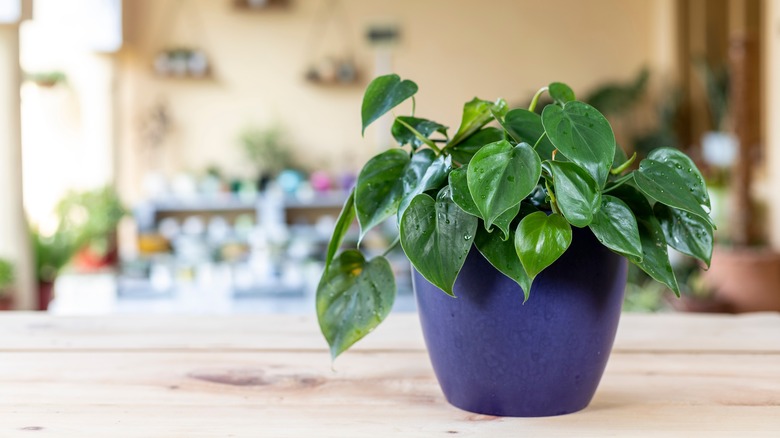The Best Way To Propagate Heartleaf Philodendron
What is better than a beautiful houseplant? An endless supply of beautiful houseplants! While I do most of my warm season gardening outdoors, I cannot bear a winter without tending to some kind of greenery. As a master gardener, I'm always looking for new plants, but I also love tried and true favorites like the heartleaf philodendron (Philodendron hederaceum). As the name implies, the deep green leaves have a beautiful heart shape. This plant tolerates a wide range of indoor conditions, including low light and a fair amount of neglect. The heartleaf philodendron is even easy to propagate – all you need is water, a bit of light, and a little time.
There are many reasons to propagate plants. Sometimes vines, like the heartleaf philodendron, can look a bit spindly, so adding more plants to the pot fills it out nicely. Occasionally, there may be an accident where a portion of the stem gets damaged and must be removed. Rooting that vine is the perfect way to make the most of an unfortunate situation. My favorite reason for taking cuttings to propagate my houseplants is to share. Since the heartleaf philodendron is so easy to grow, it's an excellent choice as a housewarming gift, an easy-to-care-for funeral plant, or just a loving gesture for friends.
Water propagation for endless plants
The key to getting a healthy plant (or multiple plants) from your heartleaf philodendron is taking an appropriate cutting. If you try to root a leaf without a node, you could end up with zombie leaf propagation, which is when a leaf roots but lacks the ability to grow into a full plant. To propagate this vine, a stem portion with 3 to 5 leaves is ideal, which will ensure there is at least one node from which roots can form. Each node is opposite a leaf, so make your cutting about half an inch above the leaf with a clean pair of shears. If you are propagating an extremely leggy plant, you can take a section with two leaves. Just make sure your cutting has at least one node and one leaf so it can perform photosynthesis while it grows roots.
Once you have your cutting the next step is pretty simple: put it in water. You'll need to make sure the node or nodes are consistently submerged. It's also important to change out the water every couple of days to prevent pathogens from growing. As long as those nodes stay in water, they will quickly form roots. If you're rooting several cuttings from one plant, or even different kinds of plants, it might be fun to try to use a pool noodle to successfully propagate plants. Place your cuttings in an area that gets natural light and let it get to work.
Potting and caring for your heartleaf philodendron
Once your heartleaf philodendron cutting has formed roots that are an inch or so long, it's time to move it into a planter. If you are adding cuttings to help an existing plant look more full, you can carefully dig a hole in that planter to insert your new plant. It also never hurts to give your older plants a good cleaning and fresh soil. In this case, you can simply replant everything together, which is the ideal option if you are combining multiple cuttings with an existing plant.
For those propagating for extra houseplants or gifts, select a container with good drainage and use high quality potting soil. The stem can be buried up to about an inch below the bottom leaf. I like to give my plants a boost after planting by watering thoroughly with a liquid fertilizer mixed according to the package instructions. Keep the soil moist by watering any time the surface is dry, typically once a week.


